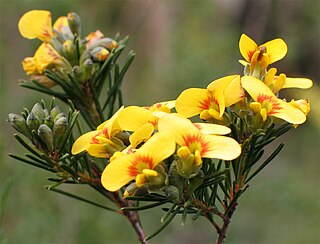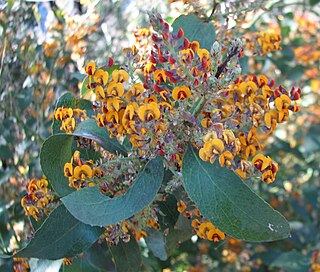
Correa is a genus of eleven species of flowering plants in the family Rutaceae that are endemic to Australia. Plants in the genus Correa are shrubs to small trees with simple leaves arranged in opposite pairs, bisexual flowers with four sepals, four petals usually fused for most of their length and eight stamens.

Pomaderris is a genus of about 80 species of flowering plants in the family Rhamnaceae, the species native to Australia and/or New Zealand. Plants in the genus Pomaderris are usually shrubs, sometimes small trees with simple leaves arranged alternately along the branches and bisexual, woolly-hairy flowers arranged in racemes or panicles. The flowers are usually yellow and often lack petals.

Dillwynia is a genus of about 20 species of flowering plants in the family Fabaceae, and is endemic to Australia. Plants in this genus are shrubs with simple leaves and yellow or red and yellow flowers similar to others in the family.

Cassinia is a genus of about fifty-two species of flowering plants in the family Asteraceae that are native to Australia and New Zealand. Plants in the genus Cassinia are shrubs, sometimes small trees with leaves arranged alternately, and heads of white, cream-coloured, yellow or pinkish flowers surrounded by several rows of bracts.

Hovea is a genus of about forty species of flowering plants in the family Fabaceae, and is endemic to Australia. Plants in this genus are sub-shrubs, shrubs or small trees with simple leaves and purple, blue or mauve flowers with a white centre. The fruit is a pod containing brown to blackish seeds. Species of Hovea occur in all Australian states, the Australian Capital Territory and the Northern Territory.

Kennedia is a genus of thirteen species of flowering plants in the pea family Fabaceae and is endemic to Australia. Plants in this genus are prostrate or climbing perennials with trifoliate leaves and large, showy, pea-like flowers. There are species in all Australian states.

Mirbelia is a plant genus belonging to the family Fabaceae and is endemic to Australia, occurring in every mainland state except South Australia. Plants in the genus Mirbelia are prickly, perennial shrubs with simple, sometimes sharply-pointed leaves, or the leaves absent. The flowers are arranged singly or in groups in leaf axils or on the ends of branches, the sepals joined at the base with five teeth. The petals are usually red, orange, purplish or bluish and the fruit is an inflated pod.

Gompholobium, commonly known as glory peas or wedge-peas, is a genus of plants in the pea family Fabaceae and is endemic to Australia. Most species have compound leaves composed of three leaflets and all have ten stamens which are free from each other and a distinctive arrangement of their sepals.

Bossiaea is a genus of about 78 species of flowering plants in the pea family Fabaceae and is endemic to Australia. Plants in this genus often have stems and branches modified as cladodes, simple, often much reduced leaves, flowers with the upper two sepal lobes larger than the lower three, usually orange to yellow petals with reddish markings, and the fruit a more or less flattened pod.

Lasiopetalum, commonly known as velvet bushes, is a genus of about forty-five species of flowering plants in the family Malvaceae, all endemic to Australia.

Daviesia, commonly known as bitter-peas, is a genus of about 130 species of flowering plants in the family Fabaceae, and is endemic to Australia. Plants in the genus Daviesia are shrubs or small trees with leaves modified as phyllodes or reduced to scales. The flowers are arranged singly or in groups, usually in leaf axils, the sepals joined at the base with five teeth, the petals usually yellowish with reddish markings and the fruit a pod.

Sphaerolobium is a genus of flowering plants in the family Fabaceae and is endemic to Australia, occurring in all states and territories except the Northern Territory. Species of Sphaerolobium are erect shrubs, usually with rush-like stems and yellow or red flowers similar to others in the family.

Podolobium ilicifolium, commonly known as prickly shaggy-pea, is a flowering plant in the family Fabaceae and grows in eastern and southern Australia. The inflorescence is a cluster of yellow or orange pea-like flowers with red markings and shiny green, prickly foliage.

Daviesia latifolia, commonly known as hop bitter-pea, is a species of flowering plant in the family Fabaceae and is endemic to south-eastern Australia. It is a slender, erect, spreading shrub with elliptic, egg-shaped or lance-shaped phyllodes and orange-yellow and maroon flowers in long racemes.

Oxylobium ellipticum, commonly known as the common shaggy-pea, is a flowering plant in the family Fabaceae. It has dense clusters of yellow pea flowers and elliptic-shaped leaves. It grows in south-eastern Australia.

Oxylobium arborescens, commonly known as the tall shaggy-pea, is a species of flowering shrub to small tree in the family Fabaceae and is endemic to south-eastern Australia. It has elliptic dark green leaves and yellow pea flowers.

Podolobium procumbens, commonly known as trailing shaggy-pea, trailing podolobium or trailing oxylobium, is a flowering plant in the family Fabaceae and is endemic to south-eastern Australia. It is a trailing small shrub with oval-shaped leaves and orange pea-like flowers.

Daviesia mimosoides, commonly known as blunt-leaf bitter-pea, narrow-leaf bitter pea or leafy bitter-pea, is a species of flowering plant in the family Fabaceae and is endemic to eastern continental Australia. It is an open shrub with tapering, linear, elliptic or egg-shaped phyllodes, and groups of orange-yellow and dark brownish-red to maroon flowers.

Gompholobium venustum, commonly known as handsome wedge-pea, is a species of flowering plant in the family Fabaceae and is endemic to the south-west of Western Australia. It is a slender, erect or sprawling shrub with pinnate leaves with fifteen to nineteen leaflets, and yellow or pink, pea-like flowers.
Pultenaea vestita, commonly known as feather bush-pea, is a species of flowering plant in the family Fabaceae and is endemic to south-western continental Australia. It is an erect to prostrate, sometimes mat-forming shrub with elliptic to linear or lance-shaped leaves, and yellow and red, pea-like flowers.



















